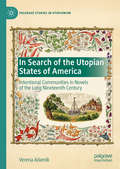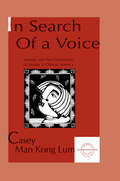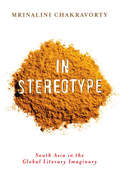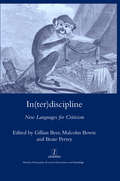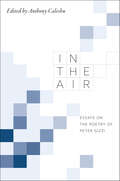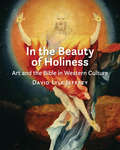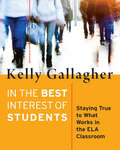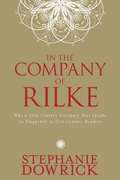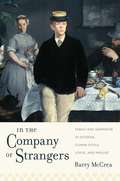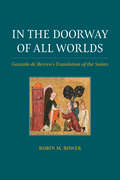- Table View
- List View
In Search of the Swan Maiden: A Narrative on Folklore and Gender
by Barbara Fass LeavyIn her compendious study, [of the folktale of the runaway wife] Leavy argues that the contradictory claims of nature and culture are embodied in the legendary figure of the swan maiden, a woman torn between the human and bestial worlds. --The New York Times Book Review This is a study of the meaning of gender as framed by the swan maiden tale, a story found in the folklore of virtually every culture. The swan maiden is a supernatural woman forced to marry, keep house, and bear children for a mortal man who holds the key to her imprisonment. When she manages to regain this key, she escapes to the otherworld, never to return. These tales have most often been interpreted as depicting exogamous marriages, describing the girl from another tribe trapped in a world where she will always be the outsider. Barbara Fass Leavy believes that, in the societies in which the tale and its variants endured, woman was the other--the outsider trapped in a society that could never be her own. Leavy shows how the tale, though rarely explicitly recognized, is frequently replayed in modern literature. Beautifully written, this book reveals the myriad ways in which the folktales of a society reflect its cultural values, and particularly how folktales are allegories of gender relations. It will interest anyone involved in literary, gender, and cultural studies.
In Search of the Utopian States of America: Intentional Communities in Novels of the Long Nineteenth Century (Palgrave Studies in Utopianism)
by Verena AdamikThis book endeavours to understand the seemingly direct link between utopianism and the USA, discussing novels that have never been brought together in this combination before, even though they all revolve around intentional communities: Imlay’s The Emigrants (1793), Hawthorne’s The Blithedale Romance (1852), Howland’s Papas Own Girl (1874), Griggs’s Imperium in Imperio (1899), and Du Bois’s The Quest of the Silver Fleece (1911). They relate nation and utopia not by describing perfect societies, but by writing about attempts to immediately live radically different lives. Signposting the respective communal history, the readings provide a literary perspective to communal studies, and add to a deeply necessary historicization for strictly literary approaches to US utopianism, and for studies that focus on Pilgrims/Puritans/Founding Fathers as utopian practitioners. This book therefore highlights how the authors evaluated the USA’s utopian potential and traces the nineteenth-century development of the utopian imagination from various perspectives.
in Search of A Voice: Karaoke and the Construction of Identity in Chinese America (Everyday Communication Series)
by Casey M.K. LumOriginating in Japan early in the 1970s as a simple sing-along technology, karaoke has become a hybrid media form designed to integrate mass-mediated popular music, video images, computer graphics, and the live musical performance of its human users. Not only has karaoke become a multimillion-dollar entertainment industry, its varied uses have also evolved into diverse popular cultural and social practices among many people around the world. Based on a two-year ethnographic study, this book offers a penetrating analysis of how karaoke is used in the expression, maintenance, and (re)construction of social identity as part of the Chinese American experience. It also explores the theoretical implications of interaction between the media audience and karaoke as both an electronic communication technology and a cultural practice. This book analyzes the social origins of karaoke and the dramaturgical characteristics of karaoke events, and explains how various musical genres are reframed as karaoke music. It also visits the numerous karaoke scenes in their natural context -- the sites of the actual consumption of media products, such as expensive private homes and fancy hotel ballrooms in the affluent suburbs of New Jersey, working-class restaurants and nightclubs in the multiethnic neighborhoods in Flushing, Queens, and Cantonese opera music clubs in New York's Chinatown. Finally, the book offers an intimate analysis of how karaoke has been adopted by several interpretive communities of first-generation Chinese immigrants not only as popular entertainment but also as a means to help (re)define their social identity and way of life.
In Short: A Collection of Brief Creative Nonfiction
by Mary Paumier Jones Judith KitchenWelcome to the first anthology to identify and celebrate a new nonfiction form: the Short! Something is going on out there. Almost simultaneously, many of our finest writers are experimenting with a new nonfiction form: brief pieces that are literary and personal rather than informational, complete in themselves, and short―very short. Although the form has not had a name until now, the writers who are attracted to it include the known―Tim O'Brien, Barry Lopez, Terry Tempest Williams, Michael Ondaatje―as well as just-discovered voices in the field of creative nonfiction, a genre that is transforming the essay. Delights and surprises await the reader in this rich gathering of Shorts. From Diane Ackerman's fascination with hummingbirds, to Andrei Codrescu's idiosyncratic view of nostalgia, to Albert Goldbarth's free-wheeling riff on the universe, each Short―ranging from several paragraphs to 2,000 words―becomes a sharply focused lens on an outer world or an inner sensibility. In Short, reflecting almost every way in which nonfiction can be written, is for all readers (and writers) who thrive on imaginative play and aesthetic satisfaction. Pick up this book; open it up. See if you can resist it.
In Spite of Partition: Jews, Arabs, and the Limits of Separatist Imagination (Translation/Transnation #17)
by Gil Z. HochbergPartition--the idea of separating Jews and Arabs along ethnic or national lines--is a legacy at least as old as the Zionist-Palestinian conflict. Challenging the widespread "separatist imagination" behind partition, Gil Hochberg demonstrates the ways in which works of contemporary Jewish and Arab literature reject simple notions of separatism and instead display complex configurations of identity that emphasize the presence of alterity within the self--the Jew within the Arab, and the Arab within the Jew. In Spite of Partition examines Hebrew, Arabic, and French works that are largely unknown to English readers to reveal how, far from being independent, the signifiers "Jew" and "Arab" are inseparable. In a series of original close readings, Hochberg analyzes fascinating examples of such inseparability. In the Palestinian writer Anton Shammas's Hebrew novel Arabesques, the Israeli and Palestinian protagonists are a "schizophrenic pair" who "have not yet decided who is the ventriloquist of whom." And in the Moroccan Jewish writer Albert Swissa's Hebrew novel Aqud, the Moroccan-Israeli main character's identity is uneasily located between the "Moroccan Muslim boy he could have been" and the "Jewish Israeli boy he has become." Other examples draw attention to the intricate linguistic proximity of Hebrew and Arabic, the historical link between the traumatic memories of the Jewish Holocaust and the Palestinian Nakbah, and the libidinal ties that bind Jews and Arabs despite, or even because of, their current animosity.
In Stereotype: South Asia in the Global Literary Imaginary
by Mrinalini ChakravortyConfronts the importance of cultural stereotypes in shaping the ethics and reach of global literature.
In Stereotype: South Asia in the Global Literary Imaginary (Literature Now)
by Mrinalini ChakravortyIn Stereotype confronts the importance of cultural stereotypes in shaping the ethics and reach of global literature. Mrinalini Chakravorty focuses on the seductive force and explanatory power of stereotypes in multiple South Asian contexts, whether depicting hunger, crowdedness, filth, slums, death, migrant flight, terror, or outsourcing. She argues that such commonplaces are crucial to defining cultural identity in contemporary literature and shows how the stereotype's ambivalent nature exposes the crises of liberal development in South Asia.In Stereotype considers the influential work of Salman Rushdie, Aravind Adiga, Michael Ondaatje, Monica Ali, Mohsin Hamid, and Chetan Bhagat, among others, to illustrate how stereotypes about South Asia provide insight into the material and psychic investments of contemporary imaginative texts: the colonial novel, the transnational film, and the international best-seller. Probing circumstances that range from the independence of the Indian subcontinent to poverty tourism, civil war, migration, domestic labor, and terrorist radicalism, Chakravorty builds an interpretive lens for reading literary representations of cultural and global difference. In the process, she also reevaluates the fascination with transnational novels and films that manufacture global differences by staging intersubjective encounters between cultures through stereotypes.
In Stereotype: South Asia in the Global Literary Imaginary
by Mrinalini ChakravortyConfronts the importance of cultural stereotypes in shaping the ethics and reach of global literature.
In Stereotype: South Asia in the Global Literary Imaginary
by Mrinalini ChakravortyConfronts the importance of cultural stereotypes in shaping the ethics and reach of global literature.
In(ter)discipline: New Languages for Criticism
by Gillian Beer"'Interdisciplinarity' has dynamised the Modern Humanities like no other recent academic trend. Yet, this presents serious challenges involving both translation and affect: how can we transmit facts and interpretations, sense and sensations between disciplines, between different artistic media, between cultures, between the private and the public sphere? What are the advantages, the difficulties, and risks? Another challenge concerns language: if single disciplines have produced their own technologies of reading and writing, this book examines and breaks the routine to propose alternative languages. Some of the most distinctive voices in criticism, both established and upcoming, from literature, music, the visual arts, psychoanalysis and philosophy, amongst others, show here their commitment to comparative thinking. The challenge has been to reach beyond the jargon and the epistemological constraints of individual disciplines while remaining coherent and incisive. The outcome successfully reveals new links between different forms of cultural expression. Gillian Beer (English Literature, Science Writing), Malcolm Bowie (French Literature, Psychoanalysis) and Beate Perrey (Music, Poetry, Psychoanalysis) are the instigators of the interdisplinary research project New Languages for Criticism: Cross-Currents and Resistances, which since 2002 has been under the auspices of CRASSH, the Centre for Research in the Arts, Social Sciences and Humanities at the University of Cambridge."
In the Air: Essays on the Poetry of Peter Gizzi
by Anthony CaleshuThis first critical book of essays on the poetry of Peter Gizzi shows how his work extends the traditions of nineteenth- and twentieth-century modernism while also reclaiming the living presence of the "lyric" in its capacity to sing of the human predicament. Gizzi is author of seven critically acclaimed books of poetry, including most recently Threshold Songs and Archeophonics, a finalist for the National Book Award in 2016. Lauded contributors, including Ben Lerner, Michael Snediker, Marjorie Perloff, and Charles Altieri, explore Gizzi's poetry for its embodiment of an American tradition—extending the poetics of Whitman, Dickinson, and Stevens, amongst others—while also exhibiting a twenty-first-century sensibility, perpetuating a new grammar and syntax to capture our place in the world today. Each essayist, in turn, works through close-readings of some of the most important poems of our times, enriching our understanding of a poetry of the mind which never loses track of what it means to feel.Hardcover is un-jacketed.
In the Anteroom of Divinity
by Feisal MohamedIn the Anteroom of Divinity focuses on the persistence of Pseudo-Dionysian angelology in England's early modern period. Beginning with a discussion of John Colet's commentary on Dionysisus' twin hierarchies, Feisal G. Mohamed explores the significance of the Dionysian tradition to the conformism debate of the 1590s through works by Richard Hooker and Edmund Spenser. He then turns to John Donne and John Milton to shed light on their constructions of godly poetics, politics and devotion, and provides the most extensive study of Milton's angelology in more than fifty years. With new philosophical, theological, and literary insights, this work offers a contribution to intellectual history and the history of religion in critical moments of the English Reformation.
In the Beauty of Holiness: Art and the Bible in Western Culture
by David Lyle JeffreyThe Academy of Parish Clergy&’s 2018 Top Five Reference Books for Parish Ministry Beauty and holiness are both highly significant subjects in the Bible. In this comprehensive study of Christian fine art David Lyle Jeffrey explores the relationship between beauty and holiness as he integrates aesthetic perspectives from the ancient Hebrew Scriptures through Augustine, Aquinas, and Kant down to contemporary philosophers of art. From the walls of the Roman catacombs to the paintings of Marc Chagall, visual art in the West has consistently drawn its most profound and generative inspiration from biblical narrative and imagery. Jeffrey guides readers through this artistic tradition from the second century to the twenty-first, astutely pointing out its relationship not only to the biblical sources but also to related expressions in liturgy and historical theology. Lavishly illustrated throughout with 146 masterworks, reproduced in full color, In the Beauty of Holiness is ideally suited to students of Christian fine art, to devotees of biblical studies, and to general readers wanting to better understand the story of Christian art through the centuries.
In the Beauty of Holiness: Art and the Bible in Western Culture
by David Lyle JeffreyThe Academy of Parish Clergy&’s 2018 Top Five Reference Books for Parish Ministry Beauty and holiness are both highly significant subjects in the Bible. In this comprehensive study of Christian fine art David Lyle Jeffrey explores the relationship between beauty and holiness as he integrates aesthetic perspectives from the ancient Hebrew Scriptures through Augustine, Aquinas, and Kant down to contemporary philosophers of art. From the walls of the Roman catacombs to the paintings of Marc Chagall, visual art in the West has consistently drawn its most profound and generative inspiration from biblical narrative and imagery. Jeffrey guides readers through this artistic tradition from the second century to the twenty-first, astutely pointing out its relationship not only to the biblical sources but also to related expressions in liturgy and historical theology. Lavishly illustrated throughout with 146 masterworks, reproduced in full color, In the Beauty of Holiness is ideally suited to students of Christian fine art, to devotees of biblical studies, and to general readers wanting to better understand the story of Christian art through the centuries.
In the Beginning: A Short History of the Hebrew Language
by Joel HoffmanDecodes the long history of Hebrew and its influential place as the ancestor of many modern written languagesHebrew as a language is just over 3,000 years old, and the story of its alphabet is unique among the languages of the world. Hebrew set the stage for almost every modern alphabet, and was arguably the first written language simple enough for everyone, not just scribes, to learn, making it possible to make a written record available to the masses for the first time. Written language has existed for so many years—since around 3500 BCE—that most of us take it for granted. But as Hoffman reveals in this entertaining and informative work, even the idea that speech can be divided into units called “words” and that these words can be represented with marks on a page, had to be discovered. As Hoffman points out, almost every modern system of writing descends from Hebrew; by studying the history of this language, we can learn a good deal about how we express ourselves today.Hoffman follows and decodes the adventure that is the history of Hebrew, illuminating how the written record has survived, the significance of the Dead Sea Scrolls and ancient translations, and attempts to determine how the language actually sounded. He places these developments into a historical context, and shows their continuing impact on the modern world.This sweeping history traces Hebrew's development as one of the first languages to make use of vowels. Hoffman also covers the dramatic story of the rebirth of Hebrew as a modern, spoken language.Packed with lively information about language and linguistics and history, In the Beginning is essential reading for both newcomers and scholars interested in learning more about Hebrew and languages in general.
In the Belly of a Laughing God
by Jennifer AndrewsHow can humour and irony in writing both create and destroy boundaries? In the Belly of a Laughing God examines how eight contemporary Native women poets in Canada and the United States - Joy Harjo, Louise Halfe, Kimberly Blaeser, Marilyn Dumont, Diane Glancy, Jeannette Armstrong, Wendy Rose, and Marie Annharte Baker - employ humour and irony to address the intricacies of race, gender, and nationality. While recognizing that humour and irony are often employed as methods of resistance, this careful analysis also acknowledges the ways that they can be used to assert or restore order.Using the framework of humour and irony, five themes emerge from the words of these poets: religious transformations; generic transformations; history, memory, and the nation; photography and representational visibility; and land and the significance of 'home.' Through the double-voice discourse of irony and the textual surprises of humour, these poets challenge hegemonic renderings of themselves and their cultures, even as they enforce their own cultural norms.
In the Best Interest of Students: Staying True to What Works in the ELA Classroom
by Kelly GallagherIn his new book,In the Best Interest of Students: Staying True to What Works in the ELA Classroom , teacher and author Kelly Gallagher notes that there are real strengths in the Common Core standards, and there are significant weaknesses as well. He takes the long view, reminding us that standards come and go but good teaching remains grounded in proven practices that sharpen students' literacy skills.Instead of blindly adhering to the latest standards movement, Gallagher suggests:Increasing the amount of reading and writing students are doing while giving students more choice around those activitiesBalancing rigorous, high-quality literature and non-fiction works with student-selected titlesEncouraging readers to deepen their comprehension by moving beyond the four corners of the text-Planning lessons that move beyond Common Core expectations to help young writers achieve more authenticity through the blending of genresUsing modeling to enrich students' writing skills in the prewriting, drafting, and revision stagesResisting the de-emphasis of narrative and imaginative reading and writingAmid the frenzy of trying to teach to a new set of standards, Kelly Gallagher is a strong voice of reason, reminding us that instruction should be anchored around one guiding question: What is in the best interest of our students?
In the Blue Pharmacy
by Marianne BoruchCollected here are sixteen essays on poets and poetry, the writing life, and a host of fascinating topics that come into the wide range of Marianne Boruch's attention. She examines how the imagination works with mystery and surprise in a variety of poets from Elizabeth Bishop to Theodore Roethke, from Russell Edson to Larry Levis, from Walt Whitman to Eavan Boland. Combining a richly associative personal style with original insights on poetic texts and historical and cultural musing, Boruch considers how the atomic bomb changed William Carlos Williams's deepest ambition for poetry, and how Edison's listening, through his famous deafness, informs our sense of the poetic line. Other essays explore how the car-its danger and solitude-helps us understand American poetry or how Dvorak and Whitman shared darker things than their curious love for trains. Poetry transforms, changing over time in the work of individual poets as well as changing us as we read it or write it.Boruch's writing has a musical, incantatory style, creating a mood in which many of her subjects are immersed. Her approach isn't meant to fix or crystallize her ideas in any hard and fast light, but rather to present the music of her thinking.
In the Blue Pharmacy
by Marianne BoruchCollected here are sixteen essays on poets and poetry, the writing life, and a host of fascinating topics that come into the wide range of Marianne Boruch's attention. She examines how the imagination works with mystery and surprise in a variety of poets from Elizabeth Bishop to Theodore Roethke, from Russell Edson to Larry Levis, from Walt Whitman to Eavan Boland. Combining a richly associative personal style with original insights on poetic texts and historical and cultural musing, Boruch considers how the atomic bomb changed William Carlos Williams's deepest ambition for poetry, and how Edison's listening, through his famous deafness, informs our sense of the poetic line. Other essays explore how the car-its danger and solitude-helps us understand American poetry or how Dvorak and Whitman shared darker things than their curious love for trains. Poetry transforms, changing over time in the work of individual poets as well as changing us as we read it or write it.Boruch's writing has a musical, incantatory style, creating a mood in which many of her subjects are immersed. Her approach isn't meant to fix or crystallize her ideas in any hard and fast light, but rather to present the music of her thinking.
In the Company of Radical Women Writers
by Rosemary HennessyRecovering the bold voices and audacious lives of women who confronted capitalist society&’s failures and injustices in the 1930s—a decade unnervingly similar to our own In the Company of Radical Women Writers rediscovers the political commitments and passionate advocacy of seven writers—Black, Jewish, and white—who as young women turned to communism around the Great Depression and, over decades of national crisis, spoke to issues of labor, land, and love in ways that provide urgent, thought-provoking guidance for today. Rosemary Hennessy spotlights the courageous lives of women who confronted similar challenges to those we still face: exhausting and unfair labor practices, unrelenting racial injustice, and environmental devastation.As Hennessy brilliantly shows, the documentary journalism and creative and biographical writings of Marvel Cooke, Louise Thompson Patterson, Claudia Jones, Alice Childress, Josephine Herbst, Meridel Le Sueur, and Muriel Rukeyser recognized that life is sustained across a web of dependencies that we each have a duty to maintain. Their work brought into sharp focus the value and dignity of Black women&’s domestic work, confronted the destructive myths of land exploitation and white supremacy, and explored ways of knowing attuned to a life-giving erotic energy that spans bodies and relations. In doing so, they also expanded the scope of American communism.By tracing the attention these seven women pay to &“life-making&” as the relations supporting survival and wellbeing—from Harlem to the American South and Midwest—In the Company of Radical Women Writers reveals their groundbreaking reconceptions of the political and provides bracing inspiration in the ongoing fight for justice.
In the Company of Rilke
by Stephanie DowrickIn the Company of Rilke is a rare book about a rare poet. Rainer Maria Rilke was a giant of twentieth-century writing who remains a visionary voice for our own time, captivating readers not only with his brilliance but also his fearlessness about the "deepest things. " Speaking through his own contradictions and ambivalence, he offers readers a profound understanding of the complex beauty and depth of human existence. Here, as in Rilke's own writing, questions matter more than answers. Here, a poet can speak directly to God while also doubting God. Astonishingly, this is the first major study of Rilke from a spiritual perspective, even though the greatest of Rilke' s gifts was to show how inevitably life centres upon a profound mystery-to which we can freely open ourselves. Drawing on her deep understanding of the gifts of Rilke's writings, as well as her own personal spiritual seeking, Dr Stephanie Dowrick offers an intimate and accessible appreciation of this most exceptional poet and his transcendent work.
In the Company of Strangers: Family and Narrative in Dickens, Conan Doyle, Joyce, and Proust (Modernist Latitudes)
by Barry McCreaIn the Company of Strangers shows how a reconception of family and kinship underlies the revolutionary experiments of the modernist novel. While stories of marriage and long-lost relatives were a mainstay of classic Victorian fiction, Barry McCrea suggests that rival countercurrents within these family plots set the stage for the formal innovations of Joyce and Proust. Tracing the challenges to the family plot mounted by figures such as Fagin, Sherlock Holmes, Leopold Bloom, and Charles Swann, McCrea tells the story of how bonds generated by chance encounters between strangers come to take over the role of organizing narrative time and give shape to fictional worlds—a task and power that was once the preserve of the genealogical family. By investigating how the question of family is a hidden key to modernist structure and style, In the Company of Strangers explores the formal narrative potential of queerness and in doing so rewrites the history of the modern novel.
In the Company of Strangers: Family and Narrative in Dickens, Conan Doyle, Joyce, and Proust
by Barry MccreaIn the Company of Strangers shows how a reconception of family and kinship underlies the revolutionary experiments of the modernist novel. While stories of marriage and long-lost relatives were a mainstay of classic Victorian fiction, Barry McCrea suggests that rival countercurrents within these family plots set the stage for the formal innovations of Joyce and Proust. Tracing the challenges to the family plot mounted by figures such as Fagin, Sherlock Holmes, Leopold Bloom, and Charles Swann, McCrea tells the story of how bonds generated by chance encounters between strangers come to take over the role of organizing narrative time and give shape to fictional worlds--a task and power that was once the preserve of the genealogical family. By investigating how the question of family is a hidden key to modernist structure and style, In the Company of Strangers explores the formal narrative potential of queerness and in doing so rewrites the history of the modern novel.
In the Demon's Bedroom: Yiddish Literature and the Early Modern
by Jeremy DauberThis important study is the first to offer a sustained look at a variety of early modern Yiddish masterworks--and their writers and readers--paying particular attention to their treatment of supernatural themes and beings.
In the Doorway of All Worlds: Gonzalo de Berceo’s Translation of the Saints (Toronto Iberic #89)
by Robin M BowerThe thirteenth-century poet Gonzalo de Berceo is the first named author of Old Spanish letters and the most prolific contributor to the emergence of the body of learned vernacular verse known as the mester de clerecía. In the Doorway of All Worlds focuses on the four hagiographies Berceo produced as a unified body of poetic expression and world-building. Robin M. Bower traces the poet’s intricate juxtaposition of contraries to shed light on a poetic world that will innovate a deceptively simple poetic vernacular and elevate its capacity to express nuance, power, and mystery. The book examines the entanglements that bind formal and lexical choices, the inscription of performance sites and audiences, and problematic source authority. It argues that Berceo’s elaboration of a poetic vernacular was wholly enmeshed in the immediate human, experiential world and the diverse cultural, religious, linguistic, and literary contexts that framed it. The book also highlights how Berceo invented a literary vernacular that befits the spoken idiom not only for the crafting of learned fictions, but for giving linguistic shape to the ineffable. In the Doorway of All Worlds ultimately reveals how Berceo freed the meanings trapped in relics, shrines, and the impenetrable texts from which he translated the saints to circulate in a new time.

